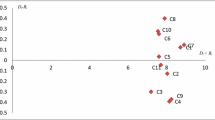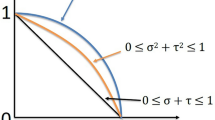Abstract
Collaborating businesses are expected to be mutually beneficial and act as a single entity. It is possible to achieve the goals thanks to the businesses that come together in an industrial symbiosis network. Two (or more) businesses benefit in an industrial symbiosis relationship. The selection of enterprises in which industrial symbiosis can be established is a difficult task due to the different criteria that must be considered. In this study, the assessment of companies for industrial symbiosis is examined. The alternatives are evaluated with circular intuitionistic fuzzy numbers according to the criteria by experts, and a new circular intuitionistic fuzzy MCDM approach is developed. In addition to the existing literature, this study contributes to the circular intuitionistic fuzzy sets by proposing a new score function. This application is intended to guide future circular intuitionistic fuzzy MCDM approaches.
Access this chapter
Tax calculation will be finalised at checkout
Purchases are for personal use only
Similar content being viewed by others
References
Chertow, M.R.: “Uncovering” industrial symbiosis. J. Ind. Ecol. 11, 11–30 (2007). https://doi.org/10.1162/jiec.2007.1110
Costa, I., Massard, G., Agarwal, A.: Waste management policies for industrial symbiosis development: case studies in European countries. J. Clean. Prod. 18, 815–822 (2010). https://doi.org/10.1016/j.jclepro.2009.12.019
Neves, A., Godina, R., Azevedo, S.G., Pimentel, C., Matias, J.C.O.: The potential of industrial symbiosis: case analysis and main drivers and barriers to its implementation. Sustainability 11, 7095 (2019). https://doi.org/10.3390/su11247095
Domenech, T., Bleischwitz, R., Doranova, A., Panayotopoulos, D., Roman, L.: Mapping Industrial symbiosis development in Europe_ typologies of networks, characteristics, performance and contribution to the circular economy. Resour. Conserv. Recy. 141, 76–98 (2019). https://doi.org/10.1016/j.resconrec.2018.09.016
Felicio, M., Amaral, D., Esposto, K., Durany, X.G.: Industrial symbiosis indicators to manage eco-industrial parks as dynamic systems. J. Clean. Prod. 118, 54–64 (2016). https://doi.org/10.1016/j.jclepro.2016.01.031
Özkan, A., Günkaya, Z., Özdemir, A., Banar, M.: Sanayide Temiz Üretim Ve Döngüsel Ekonomiye Geçişte Endüstriyel Simbiyoz Yaklaşimi: Bir Değerlendirme. Anadolu Univ. J. Sci. Technol. B-Theor. Sci., 6, 84–97 (2018). https://doi.org/10.20290/aubtdb.332377
Zhao, H., Zhao, H., Guo, S.: Evaluating the comprehensive benefit of eco-industrial parks by employing multi-criteria decision making approach for circular economy. J. Clean. Prod. 142, 2262–2276 (2017). https://doi.org/10.1016/j.jclepro.2016.11.041
Alakaş, H.M., Gür, Ş., Özcan, E., Eren, T.: Ranking of sustainability criteria for industrial symbiosis applications based on ANP. J. Environ. Eng. and Landsc. Manag. 28, 192–201 (2020). https://doi.org/10.3846/jeelm.2020.13689
Vimal, K.E.K., Jayakrishna, K., Ameen, T., Afridhi, S.S., Vasudevan, V.: An investigation on the impact of industrial symbiosis implementation on organizational performance using analytical hierarchical approach. Benchmarking Int. J. 27, 886–911 (2020). https://doi.org/10.1108/BIJ-12-2018-0423
Jayakrishna, K., Kek, V., Vibha, M., Jain, S., Kulatunga, A.K.: Fostering systematic eco-innovation in an industrial symbiosis environment using DEMATEL. Int. J. Ind. Syst. Eng. 34, 20–42 (2020). https://doi.org/10.1504/IJISE.2020.104314
Li, Y., Pinto, M.C.B.: Analyzing the critical success factors for industrial symbiosis—a Chinese perspective. In: Phanden, R.K., Mathiyazhagan, K., Kumar, R., Paulo Davim, J. (eds.) Advances in Industrial and Production Engineering. LNME, pp. 23–33. Springer, Singapore (2021). https://doi.org/10.1007/978-981-33-4320-7_3
Zadeh, L.A.: Fuzzy sets. Inf. Control. 8, 338–353 (1965). https://doi.org/10.1016/S0019-9958(65)90241-X
Smarandache, F.: Neutrosophy: neutrosophic probability, set, and logic: analytic synthesis and synthetic analysis (1998)
Torra, V.: Hesitant fuzzy sets. Int. J. Intell. Syst. 25, 529–539 (2010). https://doi.org/10.1002/int.20418
Atanassov, K.: Intuitionistic fuzzy sets. Fuzzy Set. Syst. 20, 87–96 (1986). https://doi.org/10.1016/S0165-0114(86)80034-3
Atanassov, K.: Circular intuitionistic fuzzy sets. J. Intell. Fuzzy Syst. 39, 5981–5986 (2020). https://doi.org/10.3233/JIFS-189072
Kahraman, C., Alkan, N.: Circular intuitionistic fuzzy TOPSIS method with vague membership functions: supplier selection application context. Notes Intuitionistic Fuzzy Set 27, 24–52 (2021). https://doi.org/10.7546/nifs.2021.27.1.24-52
Chen, S., Tan, J.: Handling multi criteria fuzzy decision making problems based on vague set theory. Fuzzy Set Syst. 67, 163–172 (1994). https://doi.org/10.1016/0165-0114(94)90084-1
Xu, Z.: Intuitionistic fuzzy aggregation operators. IEEE Trans. Fuzzy Syst. 15, 1179–1187 (2007). https://doi.org/10.1109/TFUZZ.2006.890678
Geng, Y., Liu, Z., Xue, B., Dong, H., Fujita, T., Chiu, A.: Energy-based assessment on industrial symbiosis: a case of Shenyang economic and technological development zone. Environ. Sci. Pollut. Res. 21(23), 13572–13587 (2014). https://doi.org/10.1007/s11356-014-3287-8
Wahrlich, J., Simioni, F.J.: Industrial symbiosis in the forestry sector: a case study in southern Brazil. J. Ind. Ecol. 23, 1470–1482 (2019). https://doi.org/10.1111/jiec.12927
Martin, M.: Quantifying the environmental performance of an industrial symbiosis network of biofuel producers. J. Clean. Prod. 102, 202–212 (2015). https://doi.org/10.1016/j.jclepro.2015.04.063
Acknowledgements
“This work has been supported by the Scientific Research Projects Commission of Galatasaray University under grant number # FBA-2020-1036.”
Author information
Authors and Affiliations
Corresponding author
Editor information
Editors and Affiliations
Rights and permissions
Copyright information
© 2022 The Author(s), under exclusive license to Springer Nature Switzerland AG
About this paper
Cite this paper
Çakır, E., Taş, M.A., Ulukan, Z. (2022). Circular Intuitionistic Fuzzy Sets in Multi Criteria Decision Making. In: Aliev, R.A., Kacprzyk, J., Pedrycz, W., Jamshidi, M., Babanli, M., Sadikoglu, F.M. (eds) 11th International Conference on Theory and Application of Soft Computing, Computing with Words and Perceptions and Artificial Intelligence - ICSCCW-2021. ICSCCW 2021. Lecture Notes in Networks and Systems, vol 362. Springer, Cham. https://doi.org/10.1007/978-3-030-92127-9_9
Download citation
DOI: https://doi.org/10.1007/978-3-030-92127-9_9
Published:
Publisher Name: Springer, Cham
Print ISBN: 978-3-030-92126-2
Online ISBN: 978-3-030-92127-9
eBook Packages: Intelligent Technologies and RoboticsIntelligent Technologies and Robotics (R0)




